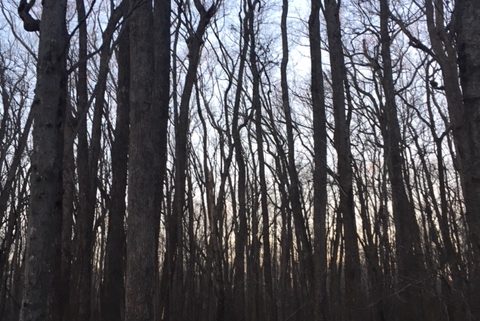Beaverdam Swamp at Wheeler NWR — Dormant Season Beauty
One arm of the Wheeler National Wildlife Refuge extends north from the Tennessee River to I-565, just three miles from our daughter Katy’s home. January 31, Judy and I retrieved local grandsons Jack and Sam from their respective schools to hike the two-mile round trip at Beaverdam Swamp, returning them to Katy’s as dusk settled. Temperature nearly 60, we enjoyed a spring-like walk in the deeply dormant hardwood bottom-land. The trail-head is within 300 feet of the Interstate. Thick forest soon muted the traffic cacophony as we headed south at 90 degrees to the highway.
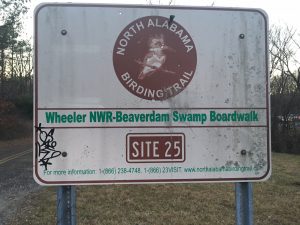
Fittingly, Jack shared with us that day’s fourth grade lessons, which focused on Gifford Pinchot, John Muir, and Rachel Carson. A perfect alignment with our venture into this small appendage to the Refuge’s 35,000 acres. The trail begins in a mature upland forest, heavy to oak and peppered with a few large loblolly pines. We graded ever-so-slowly into true bottom-land. Our gravel surface yielded to boardwalk as we entered the persistently wet tupelo swamp:
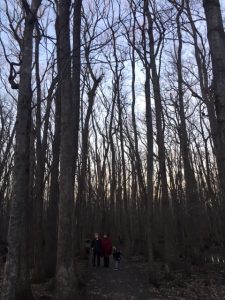
These are rich sites, with deep, fertile soils, periodically refreshed by frequent overflow of the nearby stream and the Tennessee River. Many main canopy trees from trail-head to the creek-side terminus reach 100-plus feet. On the uplands (I use the term generously; the higher ground may be only ten feet elevation above swamp level), some oaks meet the description of ‘mighty.’ Large diameter; towering boles; wide-spreading crowns. The tupelo likewise presented impressive dimensions (I must confess, I snapped this bright-sunshine photo along the same path a couple weeks prior):
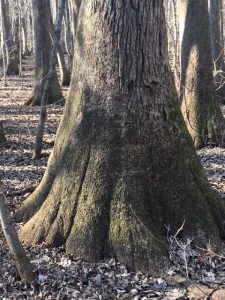
Many tupelo evidenced their advanced age via hollow trunks, tops dropped, and visible fungal fruiting bodies:
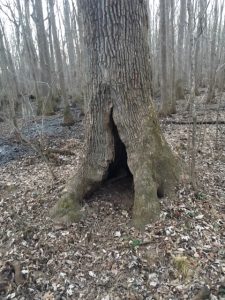
I find special beauty in the winter season hardwood forests. The crown geometry expresses the ongoing reach for light. The intricate patterns are species-determined, yet each design is driven by common purpose — capturing sunlight in service to the leafy factories. The Adaptive Geometry of Trees (Henry S, Horn, 1971) is an exquisite study of the species-dictated branching patterns and designs. Summer’s foliage masks the intriguing crown structure. As I’ve often penned, we need not search far in Nature to detect the beauty, magic, wonder, and awe that lie hidden within.
The sun kissed the horizon as we found rest at the far terminus, creek-side:
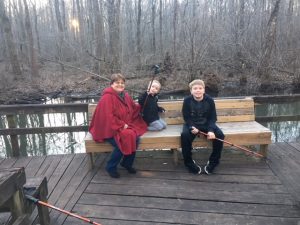
While there, we appreciated that the sun still illuminated the crowns above us:
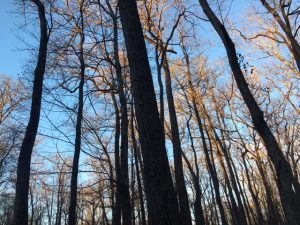
Please take note of how different the two photos appear. Judy and the boys seem to sit in rather bleak semi-light, while the sky above retains its blue and the branches bask in the day’s final rays.
I suppose this, too, offers a lesson worthy of record. Nature’s faces are many. We can choose to see only the approaching darkness… or we can rejoice in the majesty of the moment. Leonardo da Vinci 500 years ago observed, “Nature is full of infinite causes that have never occurred in experience.” He is suggesting that she offers a face for every occasion, and reminds us that over the vast sweep of time, Nature has faced all manner of situations and has the ‘experience’ to handle more than we might imagine.
I have also pointed out often that we need not visit Yellowstone or Denali National Park to experience Nature’s inspiration or feel the deep humility that she can place in our hearts. We started our hike pounded by Interstate noise. We quickly left the debilitating crescendo behind to find an oasis of peace, tranquility, and cathedral essence. I wonder how many of those drivers hurtling east and west realized what was so near at hand. The answer, I admit, is a near-zero. They are blind… oblivious to the wondrous Nature that lies within reach.
They do not know or believe that they could discover treasure so close to home. Nor do they Look or See. I shudder to think how many were also still connected to the deadly force of digital distraction. So sad. Yet I also remind myself of Aldo Leopold’s wisdom, “Conservation of all wildness is self-defeating, for to cherish, one must see and fondle. And when enough have seen and fondled, there is no wildness left to cherish.” Still, I find little solace that so few cherish this Wheeler treasure.
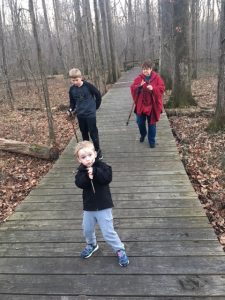
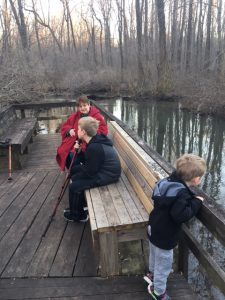
I pray that Sam and Jack will carry an embrace of Nature throughout their lives… that the seed we are planting will eventually bear fruit. We want to make sure that they never suffer from Nature Deficit Disorder. Many have asked me, “Why did you move to northern Alabama?” A photo is worth a thousand words of explanation!
My life is, and will always be, Nature-Inspired!

